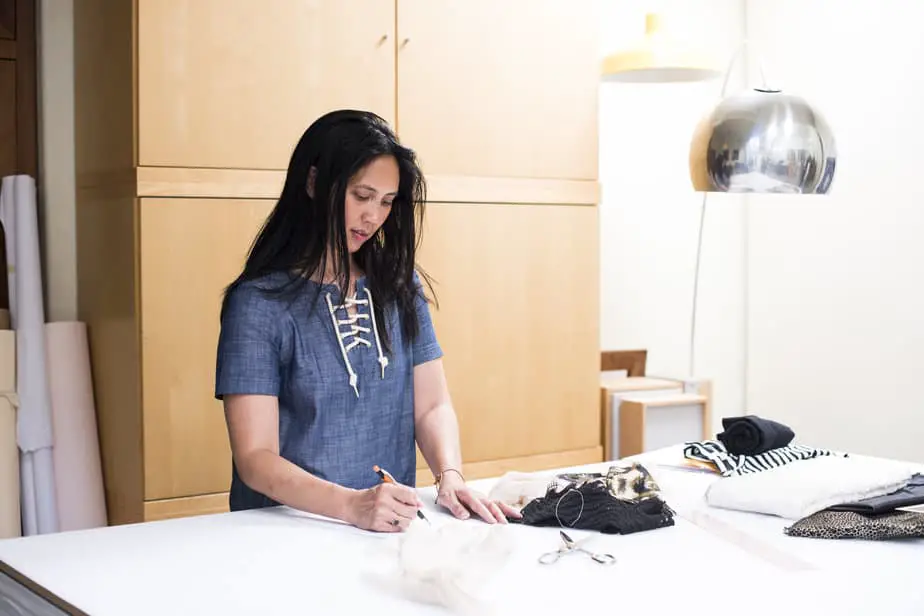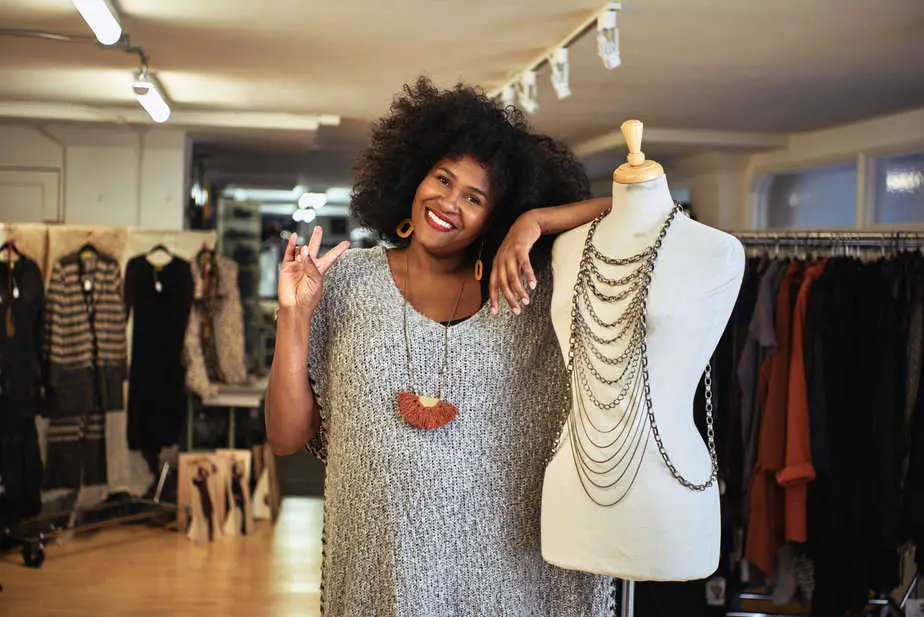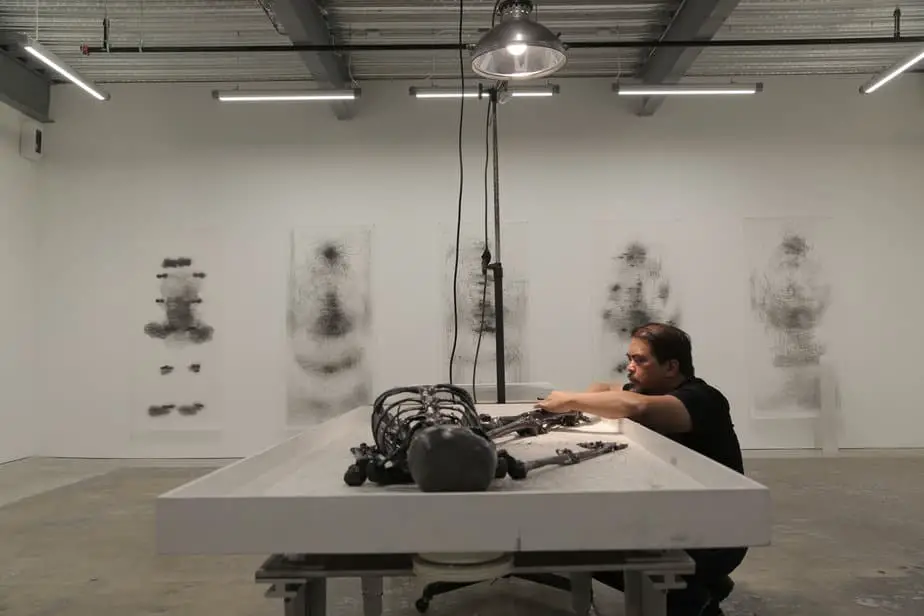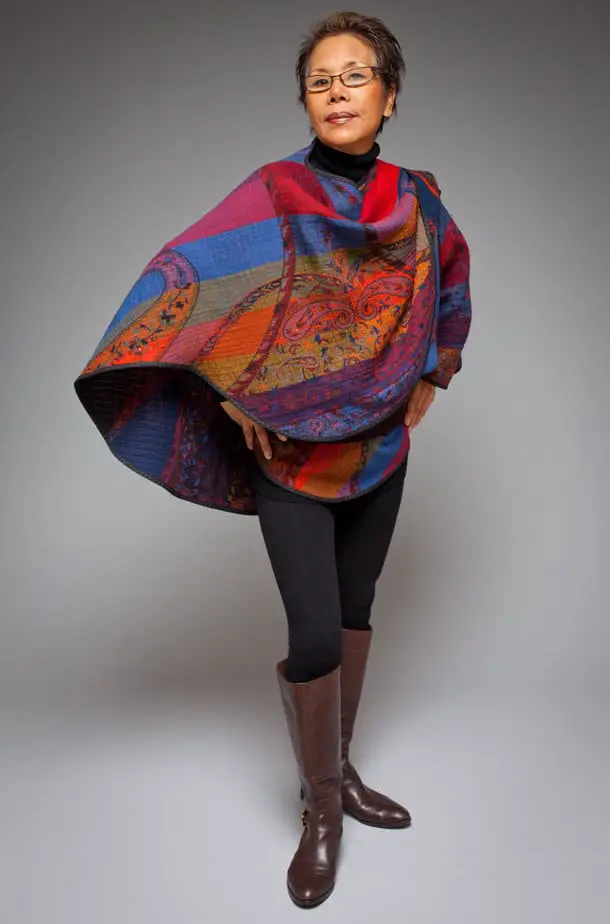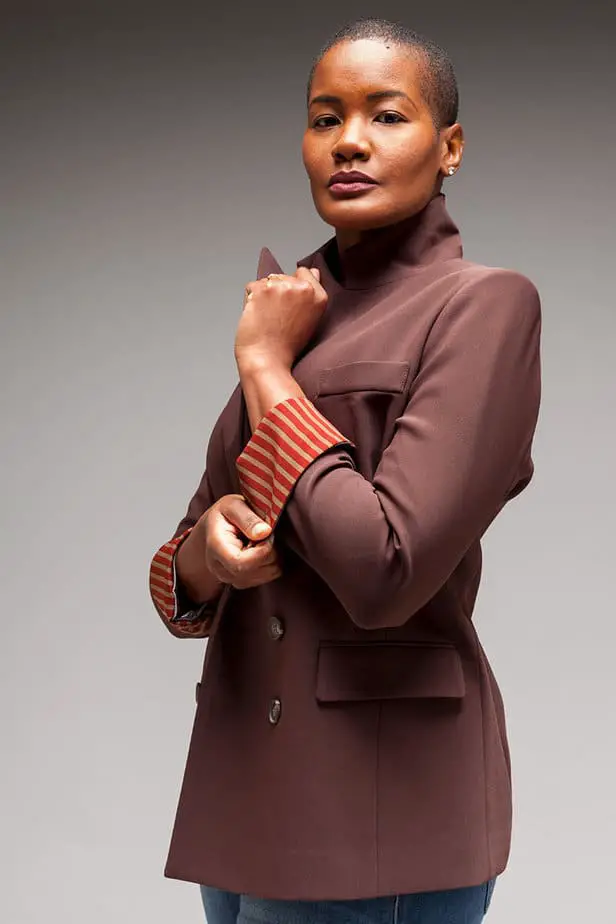Tell us more about you and how did you get started in your field? What were the inspirations that led you down your current path?
I always knew that I wanted to be a fashion designer since I was a child. I would also say it is in my genetic make-up as my grandmother was a dressmaker in the Philippines and I have artists and designers of various disciplines in my family—fashion, architecture, graphic design, fine arts, photography, and music. I feel very fortunate that our interest in the arts and design was always something that was supported and nurtured by my immediate and extended family.
Growing up in a Filipino migrant family in St. Louis, Missouri in the 70’s and 80’s and going to a Catholic school for most of my life shaped me a lot. It was a fairly conservative environment, so I used dressing up as a form of expression. I had grandiose dreams of moving to a big city and becoming a designer. During summer breaks when most kids would be playing outside, I would stay indoors, using those months to plan my Fall wardrobe and sew everything—experimenting with different fabrics and honing my sewing skills. Plus, I love the style and icons of those decades—like Jackie O., Lauren Hutton, and Jane Birkin to name a few. They transcend time, and I try to infuse a little bit of that in my line.
When I enrolled in the fashion program at Otis College of Art and Design in LA, I was surrounded by other like-minded creatives and industry icons. I felt right at home. Along with refining my creative and technical fashion skills, Otis prepared me with the know-how for a fast-paced and competitive industry.
I was growing weary after working for two decades in the corporate apparel industry (I designed for Gap Inc., Target Corporation, and Levi’s to name a few). Then I was diagnosed with breast cancer. I realized that I needed to do something different. I really felt out of touch with my own self and yearned to create for creativity’s sake and not to design clothing for the masses (that was going to be produced overseas, making another company millions of dollars). That is the short story of how my brand Lacson Ravello was born. It is such a natural thing for me to design and make clothes in the purest sense. Establishing my own brand allowed me to rediscover that creative child again – the one who was always dreaming big and making something. Now I can’t imagine doing anything else.
When creating, when do you feel the most powerful? What does it feel like? Give us the spectrum.
I always seem to be creating in one form or another, but it’s most powerful when I can do it with a relaxed and clear mind, in my studio, with a little detachment from the outside world. Sometimes the creativity comes in moments of solitude, and sometimes it takes a village. I also love to run ideas by my husband and trusted creative cohorts. That is when a lot of magic happens. You have an initial idea, then you bounce thoughts/opinions/more ideas, and it starts to take on a life of its own. When I land on a design idea or I’m onto something good, it can feel like an endorphin rush. When I’m in that zone, I want to keep the creative momentum going even if it’s 2 o’clock in the morning. It’s a wonderful thing.
What does it mean to be an artist of color in 2020 to you? What have you recognized or learned from creating?
In previous years, I never made my Filipino heritage a huge focus of my creativity or product. It was part of my story but never at the forefront. I always considered myself a designer first, an American second, and perhaps Filipino third. The events of 2020 have definitely made me re-examine all of this as a minority-owned business and as an artist. I feel the need to be more transparent, represent diversity, and show accountability.
Being an American-born Filipina, I naturally gravitated towards being more ethnically diverse—or so I thought. I did an exercise a few months ago where I tallied the number of Asian, Black, White, and Hispanic people that I’ve worked and collaborated with since starting my business. Seeing the numbers really put it in perspective. It made me realize that I could do more in the representation, inclusion, and support of our BIPOC community.
This is something that I’m more focused on now, and have a greater awareness in other artists and businesses as well. I believe this interconnectivity across racial and ethnic lines will have a greater impact on our culture as Americans and, ultimately, towards the products we create and offer.
If you have one, what’s a morning mantra you tell yourself that gives you that spark to get creating?
I have mantras to clear my mind, relax, etc., but, to get the creative juices flowing, I like to “cut out the noise”—free myself from social media chatter and most digital forms of communication. This means being in my physical-happy-quiet space (usually the studio behind my house), where I can hear and envision what’s in my head. I have my sketchbook readily available to jot down my thoughts and ideas. Sometimes I’ll play some music, but I do relish the silent moments. With everything that’s going on in our world, I’m embracing this extended quiet time.
What would you tell your day one self if you had the chance to relay early onset advice?
Oh, I’d tell myself a few things, but the main message would be along the lines of: “Carpe Diem” and “Keep Calm and Carry On”. I would tell myself that everything is going to be okay and to keep moving forward. Follow your own vision, and never compare yourself to others. Don’t lose sight of what’s really important—which is life, health, and family. Turn off the noise, and don’t sweat the small stuff. Have faith in yourself that everything will work out.
What about your community, do you feel, has benefitted your work, others work, etc? Is it going to classes? Seeing a group of people weekly? If not, what do you wish your community had more of?
With the limitations, constraints, and isolation we are all living with during the pandemic, I’ve had to rely on my local community more than ever. My fellow makers, craftspeople, and design cohorts have been my cheerleaders, therapists, and shoulders to cry on. It has been great to see the general outpouring of support and connectivity on various digital platforms such as social media and “seeing” my friends and family on Zoom chats. I’m also grateful to have my customers and followers that recognize the importance of supporting locally and sustainably-made fashion. Despite our physical distance, we had to connect on a different level and these bonds have made us stronger. It’s an inspiring space to be in, and Lacson Ravello would not be here today without this community.
Tell us about what you’re bringing to the Bay Area Craft Week? What can readers expect for this year even though we may be all crafting from home?
I’m showing my latest collection that was inspired by Jaipur, the colorful destination in India. “The Pink City” Jaipur, is known for its crafts, vibrant textiles, and architecture. Every piece in the new collection nods to this vast city, rich with culture and history, and meshes it with a laid-back, West Coast sensibility. It’s my way of traveling without leaving home.
Colors such as saffron, oxblood, indigo blue plus a hint of pink and you’re looking at the intense yet harmonious palette of our new collection. Playful floral embroideries and bold stripes speak to Jaipur’s architecture and the high-quality fabrics serve as a canvas for new silhouettes and details.
Functional back ties, peek-a-boo backs, and cap sleeves have been incorporated into the fun and functional collection, so you can keep cool and stand out. With high-quality pieces perfect for layering, you’ll have a variety of looks to carry you through the seasons.
Do you have any events, online or otherwise, coming up that our readers should know about?
This August marks the five-year milestone for Lacson Ravello and five years of being cancer-free. It has been quite a journey. During these past few months, I’ve had more time to pause and reflect than ever. I’ve been asking myself, “How do we move forward in these times? Where do we go from here?” I’ve been tossing around a few different ideas. Here’s a synopsis:
Go “seasonless”. That is to say, design fewer season-specific collections.
I will offer no more collections that launch just for the Spring or Fall months, because frankly, we don’t always shop like that. Most of us buy our clothing, because we love it and can see wearing it different ways season after season, year after year. I want Lacson Ravello to be timeless, versatile, and designed for longevity—offering a defined and stylish core collection that you can build upon. You may still see a short sleeve in the warmer months or a long sleeve in the colder months but we’ll always be thinking of how our clothes can be worn now and beyond, layered with the last or next collections. All of this aligns with our belief in #BuyLessChooseWell. I think it’s a practical and sustainable direction for our brand.
I want Lacson Ravello to be your “at-home uniform.”
Let’s face it, working and schooling from home is here to stay – at least for awhile. I’ll be offering more knit essentials and relaxed loungewear—but not just your run-of-the-mill sweats. Think of the “Elevated Sweatshirt” and knit tops that are Zoom-ready and look great from the waist up.
Addition of more sizes (XL/16-18).
I’ve heard my customers and I’m responding. Expanding our size assortment (even just adding one size segment) is a huge undertaking for this small company. Adding another size to the mix whether it’s a smaller or larger size involves a shift mainly in pattern making, inventory, and costs. I feel it’s a step in the right direction and I’m diving in with the addition of XL/16-18 to our size range.
Goal to be use 100% sustainable materials by 2022.
You may be asking, “Don’t you already use sustainable fabrics?” Yes, we do, but we can do more and better. Now that there are more sustainable fabric options than ever before, we want to make a more conscious effort and impact!
// lacsonravello.com
Tell us more about you and how did you get started in your field? What were the inspirations that led you down your current path?
I’ve always loved handmade jewelry and was a big fan of Etsy. After quitting my corporate job, and moving to Brooklyn, NY and decided I wanted to learn how to make handmade feather earrings. I watched a few youtube videos, went to the Michaels the next day, got supplies and my business was born. I’m infinitely inspired by the African Diaspora and Cosmic Geometry.
When creating, when do you feel the most powerful? What does it feel like? Give us the spectrum.
Such a great question: I feel free. I started designing in space of a clear mind and not of necessity, which allowed me to explore my creativity fully with no pressure. If feels so freeing to create, there are no boundaries and you know at the end of your creation, your piece will invoke confidence and excitement!
What does it mean to be an artist of color in 2020 to you? What have you recognized or learned from creating?
It means that we have to create meaningful work—it needs to give purpose to life and being, invoke conversation and sharing of stories. Ive learned that I don’t have to design within boundaries or what is trending. You just create from your heart and someone will love it!
If you have one, what’s a morning mantra you tell yourself that gives you that spark to get creating?
“I can do all things through Christ, who strengthens me” – Philippians 4:13
What would you tell your day one self if you had the chance to relay early onset advice?
This journey will be hard, and you will experience failure, but your hard work will pay off, so be patient.
What about your community, do you feel, has benefitted your work, others work, etc? Is it going to classes? Seeing a group of people weekly? If not, what do you wish your community had more of?
By selling at shows locally, it gave me direct contact to my community which provided me with feedback, love and support. It allowed me to see their joy when trying on my jewelry and their support of me as a maker. My community pushed me to want to continue on this journey.
Tell us about what you’re bringing to the Bay Area Craft Week? What can reader’s expect for this year even though we may be all crafting from home?
I will be showcasing my newest kids lined which launched last year! Its reversible quilts and quilted jackets with my custom art on sustainable fabrics. Its inspired by my daughter as well as the need to see representation of modern African diaspora influences through Kids lifestyle brands and quilting. I will also be showcasing some of my top selling jewelry pieces which is all handcrafted by me in my studio using brass, gold and silver.
Do you have any events, online or otherwise, coming up that our readers should know about?
Yes! Obviously the Bay Area Craft Week and I will have my annual Holiday Sale on Friday November 27th.
// candidartaccessories.com
Tell us more about you and how did you get started in your field?
Back in 1997, having recently finished graduate school at California College of the Arts— studying sculpture—I made a cast of my own hand in graphite. That material, same as what is used in pencils, allows you to write with it like a pencil. I made an edition of 365, they sold very quickly and I knew I was on to something.
What were the inspirations that led you down your current path?
I was always inspired by odd and unusual things—stuff that mystified me—nature and odd contraptions. I would always try to figure them out, and when I did, I usually lost interest. That’s why I’m probably still interested in and inspired by nature and other things that are ineffable.
When creating, when do you feel the most powerful? What does it feel like? Give us the spectrum.
After I make an artwork, I’ll sit and look at it. Sometimes, if I’m lucky, I’ll get this strange feeling, like I didn’t make it. Perhaps in the same way that a mother looks at her newborn child. She thinks “I know this thing came out of me but, I didn’t make it”. She knows she labored to bring it into the world, but she can’t claim to have orchestrated the making of it. In a similar way, I feel most powerful when I create something that feels “bigger” than me. Something outside of me; something inscrutable. That’s satisfying and powerful but it’s not my power. Sometimes of course, I don’t feel very “inspired”. I have a plan, and I carry out that plan. It’s still satisfying and I feel privileged to do it. But I wouldn’t call it powerful.
What does it mean to be an artist of color in 2020 to you? What have you recognized or learned from creating?
I feel very, very lucky. Growing up in the southern edge of San Francisco, I didn’t have an environment or family that encouraged this kind of life. As an artist of color, there were very few models I could point to for inspiration growing up or even now. You just kind of retreat into yourself—tell yourself a little story to keep yourself going; be vigilant.
Being an artist of color also gives me a unique insight to being outside of convention; outside of dominant culture. I wonder if that has made it easier for me to make artwork outside of convention. I think it did play a role in my creative vision.
As an artist of color, I also feel the need to help create opportunities for young artists who have similar circumstances that I had growing up. I’m working with a local under–resourced Public High School to implement a program that uses the graphic t-shirt to teach the fundamentals of art. Using a printmaking/silkscreen curriculum and protest poster art of the 70’s as a model.
If you have one, what’s a morning mantra you tell yourself that gives you that spark to get creating?
I can’t wait around to get a spark. I go down to the studio and start working. I like what painter Chuck Close said “Inspiration is for amateurs”. Just show up, sparks may happen or they may not. Inspiration is great, but you can’t depend on it. But if you don’t show up nothing gets done. It’s often the case where I ‘show up’ at the studio, and after moving things around, play some good jams—then stuff starts to happen sparks? That said, I usually can’t wait to get to the studio.
What would you tell your day one self if you had the chance to relay early onset advice?
Don’t carve the story of your ‘future self’ in stone. It will fall over and crush you in a comedic studio accident. Draw it with pencils and keep five times the number of erasers you think you’ll need.
What about your community, do you feel, has benefitted your work, others work, etc? Is it going to classes? Seeing a group of people weekly? If not, what do you wish your community had more of?
My work in the studio is fairly personal experience. I seem to take stock of what’s here; with me. I feel a bit more grounded when, my own voice is the context, questioning how I really want to respond to these materials. Challenging my own ideas and habits. Maybe then I might project out to others.
I have this crazy idea to create an organization called “The Society of Restless Artisans”. A Restless Artisan is kinda like an artist—without all the baggage—uncategorized. I don’t want to use the term ‘artist’. Artisan’ is more inclusive and seems to put people at ease. It can include all kinds of makers. Makers of food, ceramics, wood, painters—whatever. But these people must be ‘restless’ in their discipline, that is, they can’t be satisfied with staying in their tradition. They must experiment, fail, fail again, have an occasional success. But mostly a lot of failing. Then we’d get together once every two months or so for some food and drink and some show and tell. Food people will make food, ceramic people will make the dishes, wood people, the utensils.
Tell us about what you’re bringing to the Bay Area Craft Week? What can reader’s expect for this year even though we may be all crafting from home?
For craft week, during my online studio visit session, I’m going to focus on my most recent projects:
Ash Dancer–A life–sized, fully- articulating graphite human skeleton that draws on a specially fabricated vibrating table . Paper is laid on the table to record the movement and thus make the abstract figure drawings. reFrame Permutations—I’ve been cutting up gold-gilt frames and reconfigure them in odd and strange ways. Geometrically fragmented graphite panels are encased in the newly reconstructed frame.
Do you have any events, online or otherwise, coming up that our readers should know about?
As mentioned I question seven, as part of ACC Bay Area Craft Week, My studio will be featured in a live , online studio visit, on Sat. Sept 12th, 3-4pm. People can register at https://shop.craftcouncil.org/pages/maker-meetups. I’ll be demonstrating Ash Dancer, The reFrame project and my graphite objects.
Tell us more about you and how did you get started in your field?
Growing up in South Korea in the 60’s, we didn’t have much of anything, yet I was always searching and looking for something to create. My passion for fashion and longing for the beautiful things started at a very early age. Often I would go to the black (vintage) market where they were selling second hand clothing from the U.S. to give donations to help the orphans in South Korea. I would buy the largest skirt I could find and then remake it into my own clothing. Also the fashion magazines that showed 1940 & 1950’s fashions—they are still my favorite styles. So, it was very natural that I choose to study fashion design in college.
When creating, when do you feel the most powerful? What does it feel like? Give us the spectrum.
Creating takes a lots of time, patience, and also disappointments. But when my design brings a huge smile to the faces of my clients, and I can feel them transform, it’s nothing but joy and happiness—that is the best reward and it keeps me going.
What does it mean to be an artist of color in 2020 to you? What have you recognized or learned from creating?
I never thought of myself as an artist of color, but I do design and select all different colors. I believe that art is universal.
If you have one, what’s a morning mantra you tell yourself that gives you that spark to get creating?
I am a Buddhist, so I start very morning with chanting and Gongyo (assiduous or hard and frequent walking/practice) with essential morning walks.
What would you tell your day one self if you had the chance to relay early onset advice?
“Believe in myself.”
Do you have any events, online or otherwise, coming up that our readers should know about?
Every year I make generous donations to the SOKA university in San Diego for ‘The Celebrating a vision of Piece’.
// Bay Area Craft Week, Sept. 7th—13th, 2020, support all of these artists listed by checking out; shop.craftcouncil.org. Reader disclaimer: this article was not sponsored but was given preferential treatment. Please check out our editorial policy for more information. On Sept 8th, at 2PM PST, we’re going live with Candice Cox to talk about her process, bring a POC in the art space, and more. Follow us on Instagram. Feature photo courtesy of Candice Cox.
